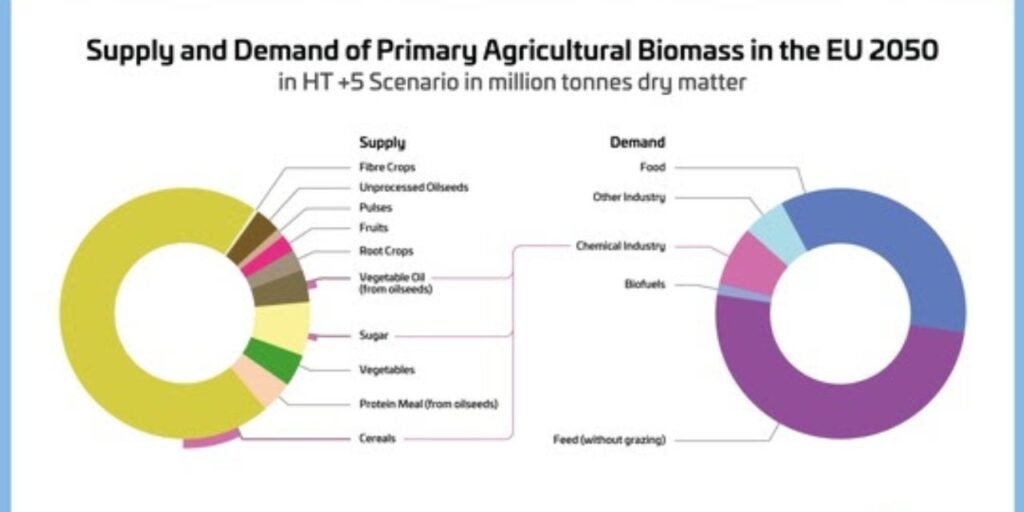
Supply and Demand of Primary Agricultural Biomass in the EU 2050
A recent research by the Biobased Industries Consortium and Renewable Carbon Initiative shows that utilising biomass might significantly defossilize the chemical sector.
According to a recent research commissioned by the Biobased Industries Consortium (BIC) and the Renewable Carbon Initiative (RCI), it is feasible and sustainable to use biomass to fulfil 20% of the chemicals and derived materials sector’s overall global carbon requirement by 2050. This important discovery emphasises the possibility of defossilising the sector, which presently gets more than 90% of its carbon requirements from fossil fuels.
More than 90% of the carbon incorporated in the chemicals and derived materials business today comes from fossil fuels like coal, natural gas, and oil—all of which are significant contributors to climate change. The embedded carbon in chemicals and materials must be defossilized and replaced with renewable alternatives derived from recycling, biogenic carbon, and carbon from CO2 in order to reach climate neutrality by 2050. According to some sources, biomass makes up about 20% of the total. Aside from the need for food and feed, there is doubt on the real amount of biomass that is accessible.
RCI and BIC commissioned a study to address the core question: Can agricultural and woody biomass together provide enough biomass to sustainably meet 20% of the future carbon demand of the chemical and derived materials industries in 2050, up from 5.5% (EU27) and 10% (global) in 2023? In cooperation with the Thünen Institute of Forestry (TI-WF, DE) and EuroCARE Agricultural Policy Research (DE), nova-Institute (DE) conducted the study.
The study created a baseline of present biomass consumption and various future scenarios to predict a variety of potential changes in order to objectively and scientifically analyse this subject. Three Green High Technology (HT), two Green Low Resource Depletion (LRD), and one Business-as-usual (BAU) scenario make up these scenarios. The changes in biomass availability for both forestry and agriculture were then examined in conjunction with EuroCare and Ti-WF.
The study’s main finding is that it is feasible and sustainable to use biomass to fulfil 20% of the chemicals and derived materials sector’s entire global carbon requirement by 2050. The 20% share can be given without jeopardising the need for biofuel and food and feed supplies under the most likely development, mild HT. Under current biofuel rules and merely a moderately high-tech agriculture system, it would be unrealistic to offer much more than 20% of carbon demand from biomass; stronger high-tech scenarios might give up to 40%.
Agriculture: It is anticipated that agricultural biomass output would increase gradually until 2050 under all circumstances. The primary cause of this is the increased demand for food and feed brought on by the projected population expansion from 7.7 billion to 9.6 billion people by 2050. Growth rates vary from 24% to 53% depending on the scenario type: business-as-usual (BAU), green low resource depletion (LRD), or green high technology (HT). For BAU, the anticipated rise is 31%, or up to 5.07 billion tonnes.
The following high-tech scenarios can meet the anticipated future demand for starch, sugar, and vegetable oil—still the main feedstocks for the chemical industry in 2050: Since the extra yield needed is just about 10% (in comparison to BAU), the mild HT+10 scenario is more than enough to satisfy the demand. Stronger high-tech scenarios in agriculture, e.g. through AI, precision farming, drones or GMO, can even provide enough biomass to significantly exceed the 20% target, up to 40%.
Therefore, it seems that technological innovation is the most crucial factor in reaching the 20% goal. At the same time, more area may be set aside for nature restoration because biomass is produced and used more efficiently in HT settings.
Maximizing Biomass Availability for a Sustainable Future
The transition to biomass-based solutions can be accelerated by expanding the use of lignocellulosic feedstocks such as straw, wood, and biowaste. However, these resources face strong competition from Sustainable Aviation Fuels (SAF), which benefit from political support and regulatory quotas.
Unlocking the Potential of Straw
The supply of usable straw could be significantly increased by incorporating corn and rice straw alongside existing sources like wheat, barley, rye, and oat straw. If fully utilized, straw could become a key feedstock in the biomass sector.
The Role of Forestry in Biomass Supply
The global demand for industrial roundwood (both coniferous and non-coniferous) is projected to grow by 38% between 2020 and 2050, increasing from 0.9 to 1.3 billion tons dry matter (t dm) per year. The most significant growth will occur in:
Asia (69%), including China and Russia
Europe (32%)
Compared to agricultural biomass, forestry-based resources show relatively minor variations across different supply scenarios.
Meeting the Chemical Industry’s Biomass Needs
The chemical and materials sector represents only a small portion of total wood demand, especially when compared to rapidly growing applications such as construction and furniture. However, this demand can still be met through:
Utilizing a small fraction of industrial roundwood supply (while evaluating cost-effectiveness).
Using by-products from roundwood processing (though competition for these materials remains high).
Reallocating a limited share of wood from the fuelwood sector.
By strategically managing biomass resources, the industry can support sustainable production while ensuring a balanced approach that does not compromise food or feed supplies.
